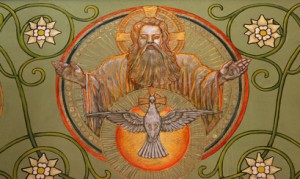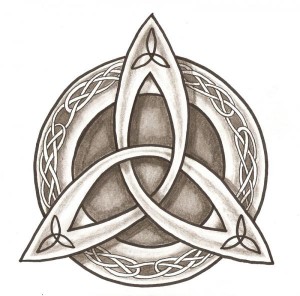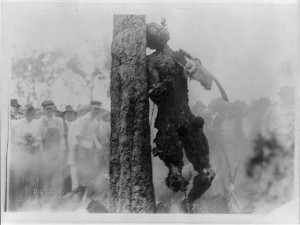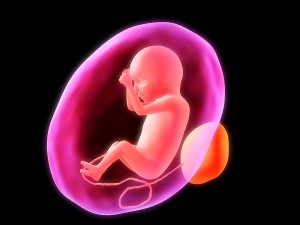====================
A sermon offered on the Second Sunday in Lent, March 1, 2015, to the people of St. Paul’s Episcopal Church, Medina, Ohio, where Fr. Funston is rector.
(The lessons for the day were Genesis 17:1-7,15-16; Psalm 22:22-30; Romans 4:13-25; and Mark 8:31-38. These lessons can be read at The Lectionary Page.)
====================
 I was an English and American literature major in college (well, I finished as an English literature major – I was a biology major, a sociology major, an anthropology major, a philosophy major, and an undeclared major before ending up with a degree in literature.) I remember a certain type of end-of-term take home exam, the compare-and-contrast question. For instance, you’d read a bunch of novels and then along would come the final exam with a question like, “Compare and contrast the vision of the sea in Hemingway’s Old Man and the Sea and Melville’s Moby Dick.”
I was an English and American literature major in college (well, I finished as an English literature major – I was a biology major, a sociology major, an anthropology major, a philosophy major, and an undeclared major before ending up with a degree in literature.) I remember a certain type of end-of-term take home exam, the compare-and-contrast question. For instance, you’d read a bunch of novels and then along would come the final exam with a question like, “Compare and contrast the vision of the sea in Hemingway’s Old Man and the Sea and Melville’s Moby Dick.”
Reading our lectionary selections today, I had the sense that I was being handed a compare-and-contrast question: Compare and contrast the covenant made by God with Abram in Genesis 17 with the demand made by Jesus in the 8th Chapter of Mark.
On the one hand, we have “I will make you exceedingly numerous. You shall be the ancestor of a multitude of nations. I will make you exceedingly fruitful.” On the other, “If any want to become my followers, let them deny themselves and take up their cross and follow me. For those who want to save their life will lose it, and those who lose their life for my sake, and for the sake of the gospel, will save it.”
On the one hand, “I will give you everything.” On the other, “Give it all up.”
And yet the process and the promise is the same. The covenant offered to Abram and the demand made by Jesus both require a decision (that’s the process) and both lead to the promise described both by Paul in his letter to the Romans and by the Psalmist in Psalm 22: “the promise that [the righteous will] inherit the world” – the promise that “they shall be known as the Lord’s for ever” – that they shall enjoy what Jesus variously described as the kingdom of God, the kingdom of heaven, eternal life, or abundant life.
As I was making my notes for this homily, I was also carrying on a conversation by internet chat with a friend and colleague about something else, and my friend quoted the late philosopher-psychiatrist Viktor Frankl. He reminded me of something Frankl, an Austrian Jew, had written in his book Man’s Search for Meaning which described the things he had observed and learned as a prisoner in the Nazi concentration camp at Auschwitz. Frankl wrote, “Between stimulus and response, there is space. In that space is our power to choose our response. In our response lies our growth and our freedom.” It occurred to me that Frankl’s “space between stimulus and response” is a key to understanding the process which is common to God’s covenant and Jesus’ requirement.
Between God’s offer to Abram and Abram’s answer, between Jesus’ demand of his disciples and their reply is what Frankl identified as this space of our power to choose, this place where our potential for growth and freedom lies entirely within our control, where we either accept the kingdom of God or reject that abundant life. God offers, Jesus mandates, but we decide. We choose our response and “in our response lies our growth and our freedom.”
In our response also lies our identity. It is important to note that it is when Abram accepts God’s offer – which he does not only for himself but for his wife Sarai, a detail we might explore at another time – he and his wife are given new names; they become Abraham (“father of many nations”) and Sarah (“princess to all”). Their new names are symbolic of their act of giving up their former lives for the sake of God’s truth. In that “space between stimulus and response,” they were freed to live and grow into the new names, the new identities that God promised to give them.
The same is true for the disciples of Jesus. In that moment of decision, that “space between stimulus and response,” they (we) are given a new name. It is not without reason that in the sacramental sign of that decision, baptism, we are given a name, “sealed by the Holy Spirit,” and “marked as Christ’s own for ever.” As Peter reminds us in his first letter, we are to “glorify God because [we] bear [the] name” of Christian.
I got to thinking about the language we use to describe the act of deciding, and particularly the difference between the way Americans describe deciding and the way the British refer to it. We are, as George Bernard Shaw is supposed to have quipped, “two countries separated by a common language.” In colloquial American speech, we “make decisions,” but in idiomatic British, one “takes a decision.” To “make” a decision, or to “take” a decision? In all honesty, I think the British have the better of us here. To take a decision is certainly more responsible and more theologically sound than to make one. Here’s what I mean . . . .
Consider the difference between “making” something and “taking” something.
When you make something . . . when you have made something, you’re done with it. You do a lot of preparation, a lot work getting ready; you put a lot into the process, and then you create whatever it is – a painting, a piece of pottery, a casserole, a pie, whatever. You make it, and then you stop making it because there it is. You’ve made it. It has an independent existence in the world. You set it on the counter and the world will do with it whatever the world will do. You can just leave it there and let the world have it.
When we “make” decisions, we do the same thing. We treat decisions as destinations, as end points. In business management courses, students are taught to use “decision trains” in which the process of deciding is metaphorically diagrammed as a locomotive passing through “stations” labeled “situation,” “factors to consider,” “desired outcomes,” “possible consequences,” and so forth, eventually arriving at the terminus labeled “decision.” We even, in everyday speech, talk about “reaching a decision.”
There! We have arrived! We’ve done it! We’ve made our decision! Set it on the counter, record it in the minutes, put it in the filing cabinet, and let the world do with it whatever the world will do. We’re finished.
But when you “take a decision” the act of deciding is not the end . . . it is the beginning. When you take something, you are doing something very different from making something. When you take something, you hold it in your hands rather than set it on the counter. When you take something, you have to do something with it rather than let the world do with it whatever the world will do. When you take a decision, you have to act on it. It is not the terminus of your decision train; it is the start of the journey. Not the end, but the beginning.
When we make a decision, our “decision train” runs from stimulus to response . . . and stops. When we take a decision, our “decision train” starts at the response and runs for the rest of our lives.
In that “space between stimulus and response,” between God’s offer of covenant and our reply, between Jesus’ demand for discipleship and our answer . . . in that space lies our power to choose, to decide, not to make a decision and simply end an old way of being, but to take a decision and begin a new way of being, to give up an old life and save a new one, to surrender our old name and take on a new name, our true name.
As Episcopal theologian Elizabeth Webb reminds us: “To know our true name is, as it was for Abraham and Sarah, to turn, to reorient ourselves according to that name, and to live it. Just as God’s naming of Abraham and Sarah was also a calling, in naming us God is calling us to discipleship, casting off the old names by which we’ve been known, and living into (and maybe ‘up to’) the name that God bestows.” Whether that name be Abraham (“father of nations”), or Sarah (“princess to all”), or, simply, Christian (“follower of Jesus”).
So . . . compare and contrast . . .
For some, the decision we must take is to accept God’s offer: “I will give you everything.” For others, the decision we must take is to follow Jesus’ demand: “Give it all up.” For all, the promise is the same: “[We] shall be [named and] known as the Lord’s for ever.” Amen.
====================
A request to my readers: I’m trying to build the readership of this blog and I’d very much appreciate your help in doing so. If you find something here that is of value, please share it with others. If you are on Facebook, “like” the posts on your page so others can see them. If you are following me on Twitter, please “retweet” the notices of these meditations. If you have a blog of your own, please include mine in your links (a favor I will gladly reciprocate). Many thanks!
====================
Father Funston is the rector of St. Paul’s Episcopal Church, Medina, Ohio.
 What is Lent all about?
What is Lent all about? Did Jesus actually say these things? Most contemporary bible scholars would probably answer “No.” The author of John’s Gospel has made Jesus say the things a largely Jewish community of the church in the late 1st Century, a church struggling to cope with its separation from traditional Judaism, believed about Jesus; Jesus is thus both the subject and the interpreter of the message of John’s Gospel. In the 21st Century, we might have preferred the author to have included the interpretation of Jesus in the narrative, not in the words spoken by the character of Jesus portrayed here, but that’s not what we’ve got. What we’ve got is the Jesus remembered by a community with a highly developed Christology telling that community, and us, who Jesus was then and now.
Did Jesus actually say these things? Most contemporary bible scholars would probably answer “No.” The author of John’s Gospel has made Jesus say the things a largely Jewish community of the church in the late 1st Century, a church struggling to cope with its separation from traditional Judaism, believed about Jesus; Jesus is thus both the subject and the interpreter of the message of John’s Gospel. In the 21st Century, we might have preferred the author to have included the interpretation of Jesus in the narrative, not in the words spoken by the character of Jesus portrayed here, but that’s not what we’ve got. What we’ve got is the Jesus remembered by a community with a highly developed Christology telling that community, and us, who Jesus was then and now. The Prayer Book version of this verse (which is differently numbered as often happens in the BCP) is this:
The Prayer Book version of this verse (which is differently numbered as often happens in the BCP) is this:
 Several days ago I was driving on the interstate highway when I encountered a man whose load of cardboard boxes had shifted and tumbled out of his truck. Traffic, of course, was slowed down and tangled up, and he was at his wit’s end trying to gather them up. I could tell that what he really wanted to do was just walk away from those boxes.
Several days ago I was driving on the interstate highway when I encountered a man whose load of cardboard boxes had shifted and tumbled out of his truck. Traffic, of course, was slowed down and tangled up, and he was at his wit’s end trying to gather them up. I could tell that what he really wanted to do was just walk away from those boxes. Does the name “Jesse Washington” mean anything to you? It’s unlikely that it does. If I tell you that Jesse Washington died in 1916 in Waco, Texas, would that spark any memory? Have you ever been taught about the incident in which Washington was killed? Have you ever heard of what came to be called “The Waco Horror?”
Does the name “Jesse Washington” mean anything to you? It’s unlikely that it does. If I tell you that Jesse Washington died in 1916 in Waco, Texas, would that spark any memory? Have you ever been taught about the incident in which Washington was killed? Have you ever heard of what came to be called “The Waco Horror?” Let me make one thing clear: I do not want to get into the abortion debate! I never want to get into the abortion debate!
Let me make one thing clear: I do not want to get into the abortion debate! I never want to get into the abortion debate! “Wrestling in his prayers” seems such an odd turn of phrase! Aren’t prayers supposed to be peaceful? The image of prayer as athletic competition (and vigorous, muscular, and very personal competition, at that) just seems contradictory. But the contradiction calls to mind two thoughts.
“Wrestling in his prayers” seems such an odd turn of phrase! Aren’t prayers supposed to be peaceful? The image of prayer as athletic competition (and vigorous, muscular, and very personal competition, at that) just seems contradictory. But the contradiction calls to mind two thoughts. He has kicked the bucket, cashed in his chips, shuffled off this mortal coil, gone the way of all flesh, croaked, gone home, passed away, turned up his toes, ridden the pale horse, fallen off his perch, taken his last bow, entered larger life, joined the choir invisible.
He has kicked the bucket, cashed in his chips, shuffled off this mortal coil, gone the way of all flesh, croaked, gone home, passed away, turned up his toes, ridden the pale horse, fallen off his perch, taken his last bow, entered larger life, joined the choir invisible.

